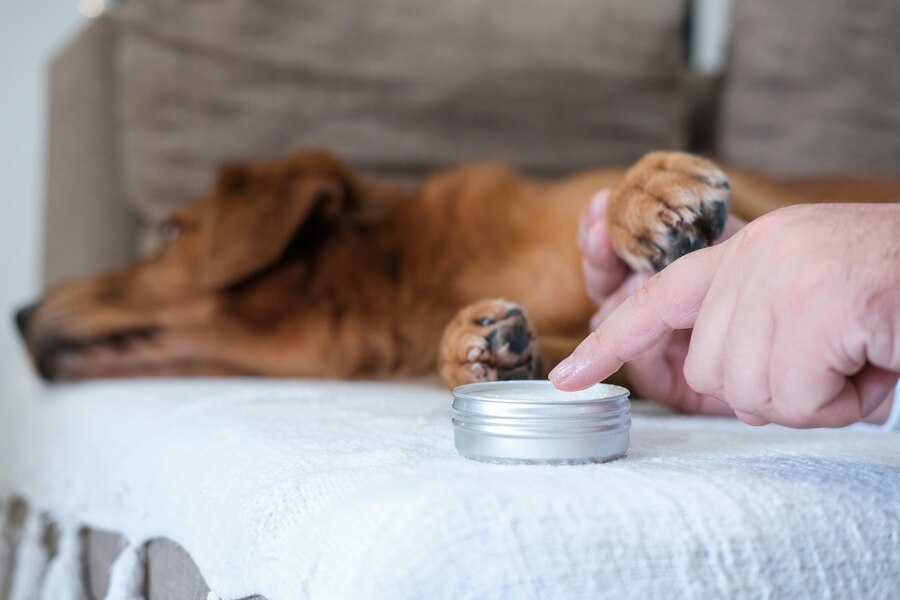Dog paw infection can be uncomfortable for your furry friend. Clean the infected paw with warm water and mild soap. Apply an antiseptic solution and keep it dry.
Prompt treatment at home can offer relief and prevent further complications. Regularly checking your dog’s paws can help catch infections early. Common causes include cuts, foreign objects, and allergies. Look for signs like redness, swelling, or unusual odor.
Cleaning the paw gently and applying an antiseptic helps fight infection. Use a dog-safe antiseptic to avoid irritation. Make sure the paw stays clean and dry. If symptoms persist or worsen, consult a veterinarian. Proper care ensures your dog’s paws stay healthy and infection-free.
Identify Symptoms
Observe for signs such as redness, swelling, or unusual discharge on your dog’s paw. Licking or limping may also indicate an infection.
Signs Of Infection
Look for redness and swelling on your dog’s paws. Check for any discharge or bad odor. Your dog may lick or chew the infected area. Watch for signs of pain or discomfort. The paw may feel warm to the touch. Be alert to any limping or favoring of one paw.
Behavioral Changes
Your dog may become less active. They might whimper or cry when walking. Notice if they are eating less or seem lethargic. They may avoid walking on certain surfaces. Changes in behavior can indicate pain or discomfort. Always keep an eye on any unusual behavior.
Clean The Affected Area
First, gather all supplies. Use a mild soap that is safe for dogs. Gently lather the infected paw with the soap. Make sure to clean between the toes. This helps remove dirt and bacteria.
After applying soap, rinse the paw with warm water. Ensure all soap is washed off. Pat the paw dry with a clean towel. Drying is important to prevent further infection. Repeat this process daily until the paw heals.
Apply Antiseptic
Clean the infected area on your dog’s paw gently. Apply antiseptic to prevent bacteria and promote healing.
Choosing The Right Antiseptic
Choose an antiseptic that is safe for dogs. Betadine or chlorhexidine are good options. Avoid using alcohol-based antiseptics. They can cause pain and further irritation. Always read the label before use. Make sure it does not contain harmful chemicals. Consult your vet if unsure.
Proper Application Techniques
First, clean your dog’s paw with warm water. Gently remove any dirt or debris. Dry the paw thoroughly with a clean towel. Apply the antiseptic using a cotton ball or pad. Make sure to cover the infected area completely. Do this gently to avoid causing pain. Let the antiseptic dry before allowing your dog to walk.
Use Natural Remedies
Coconut oil can help heal your dog’s paw infection. It has antibacterial and antifungal properties. Apply a small amount on the infected area. Massage gently to ensure it absorbs well. Repeat this twice daily for best results. Coconut oil also moisturizes the skin. It can reduce itching and irritation.
Aloe vera gel is another great remedy. It has cooling and soothing effects. Use fresh aloe vera gel for best results. Apply directly to the infected paw. Leave it on for 15 minutes. Rinse off with lukewarm water. Repeat this process twice a day. Aloe vera helps reduce inflammation and promote healing.
Bandage The Paw
Bandage the Paw guides dog owners on effectively treating paw infections at home. Learn practical steps for cleaning, bandaging, and soothing your pet’s sore paws.
Types Of Bandages
There are several types of bandages. Gauze pads are soft and absorbent. Self-adhesive wraps stick to themselves, not to the fur. Vet wrap is stretchy and provides support. Cotton rolls offer cushioning for the paw.
Correct Bandaging Method
First, clean the paw with mild soap. Dry the paw thoroughly with a clean towel. Place a gauze pad on the infected area. Wrap a self-adhesive bandage around the paw. Make sure it is snug but not too tight. Check the bandage daily for dirt or moisture. Change it if it becomes wet or soiled.
Monitor Your Dog
Check your dog’s paw daily. Look for signs of healing. Redness should decrease. Swelling should go down. Your dog should walk better. Less licking is a good sign.
Watch for new symptoms. Increased redness is a bad sign. More swelling means trouble. If your dog limps more, it is worrying. Excessive licking means pain. Any discharge needs a vet visit.
Prevent Future Infections
Check your dog’s paws every day. Look for cuts, swelling, or redness. This helps you spot problems early. Early detection can prevent serious issues.
Keep your dog’s paws clean and dry. Use a damp cloth to wipe them after walks. This removes dirt and germs. Dry the paws well to avoid moisture buildup.
When To Consult A Vet
Noticeable symptoms should improve within a few days. If swelling, redness, or pain persists, it may be serious. A vet can check for deeper issues. Home treatments are good for minor problems. A vet visit helps rule out major infections.
Severe infections need professional care. Pus, bleeding, or a bad smell are signs to watch for. Your dog may also limp or avoid using the paw. These signs mean it’s time to visit the vet. Prompt treatment prevents further complications.
Another Post: Why is My Dogs Head Hot
FAQ
How To Identify A Dog Paw Infection?
Look for redness, swelling, or discharge. Your dog may also excessively lick or chew the paw.
Can I Treat Dog Paw Infection At Home?
Yes, clean the paw with antiseptic and apply a vet-approved ointment. Monitor for improvement.
When To See A Vet For Paw Infection?
If the infection persists after home treatment, consult your veterinarian for further care.
Conclusion
Caring for a dog’s paw infection at home is possible with careful attention. Ensure cleanliness, proper medication, and regular checks. Consult a vet if symptoms persist. Home remedies can be effective, but professional advice is crucial for serious cases. Keeping your dog’s paws healthy ensures their overall well-being and happiness.

